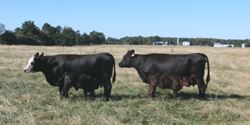|
Heifers Saved This Year Will Be Your Income Source, During The Prosperous Years Coming Up Says Extension Specialist
MT. VERNON, MO.
Is this the year to begin saving heifers? That is the question being asked by a lot of beef cow herd owners in southwest Missouri according to Eldon Cole, a livestock specialist with University of Missouri Extension.
“Forage availability certainly favors herd expansion for those operations who may have cut their numbers back in 2011 and 2012 due to dry weather,” said Cole.
Cole says whether you have last fall's or this spring's heifers to select from, there are several points to consider when deciding if they stay on the farm or get on the trailer.

A nice replacement prospect out of the 13 year old, black whitefaced cow on the left. She is the 4th daughter currently in this herd.

Longevity is an important trait. These 2, 13 year old half-sisters and their baby calves from this fall. The owner says he looks for replacements out of cows like these that calve on schedule every year.
“I suspect most selections are made based on subjective evaluation rather than true objective figures. In other words, how does she look instead of what’s her and her parent’s numbers show regarding her potential as a brood cow,” said Cole.
Number-minded folks will look at weaning weights. An adjusted, 205 day weight is the preferred weight to consider. Weights around average or above for the contemporary group of heifers is a suitable target in most herds.
“The heaviest weaning heifers usually won’t make the best cows, but likely will remain the biggest,” said Cole.
Frame size is another number to consider if heifers are actually measured. Using the Missouri frame score system, a 5 frame heifer makes a nice-sized cow for this part of the country.
According to Cole, at 205 days a heifer would be 43 to 45 inches tall at the hip. Yearlings would be 47 to 49 inches at the hip.
“The choice of frame size depends a lot on where your herd is at, where you wish to go in the future, marketing plans and whether you’re a commercial feeder calf or purebred seedstock producer,” said Cole.
As noted by Cole, expected progeny difference (EPD) of the sire of the heifers can reveal objective numbers that help evaluate her for several maternal traits.
Not all breeds have the same EPDs available but here are some to consider: calving ease maternal, milk, mature weight and height, $ energy, $ wean, docility, heifer pregnancy, stayability or longevity.
“When checking these EPDs don’t get hung up on a specific EPD number. Consider the percentile ranking and whether it’s in the top, middle or bottom for that breed. The more you know about your current cow herd’s strengths and weaknesses, the easier it will be to select replacements,” said Cole.
The dams of the prospects merit attention based on simple, observed traits, while actual weights and calving interval should also be checked.
Every herd has cows in it that are virtually “trouble free.” They calve early in the season, maintain a 12 month calving interval, never require treatment for pinkeye, foot rot, health problems with their calves are minimal, they are easy to handle, tolerate fescue, maintain a sound udder and are still going strong as a 10 year old and beyond.
“The trouble free cow is relatively hard to find, but when good management and close records are kept you should be able to improve your herd’s performance by saving their daughters. Remember, the heifers saved this year will be your income source during some prosperous years that are coming up,” said Cole.∆
|
|